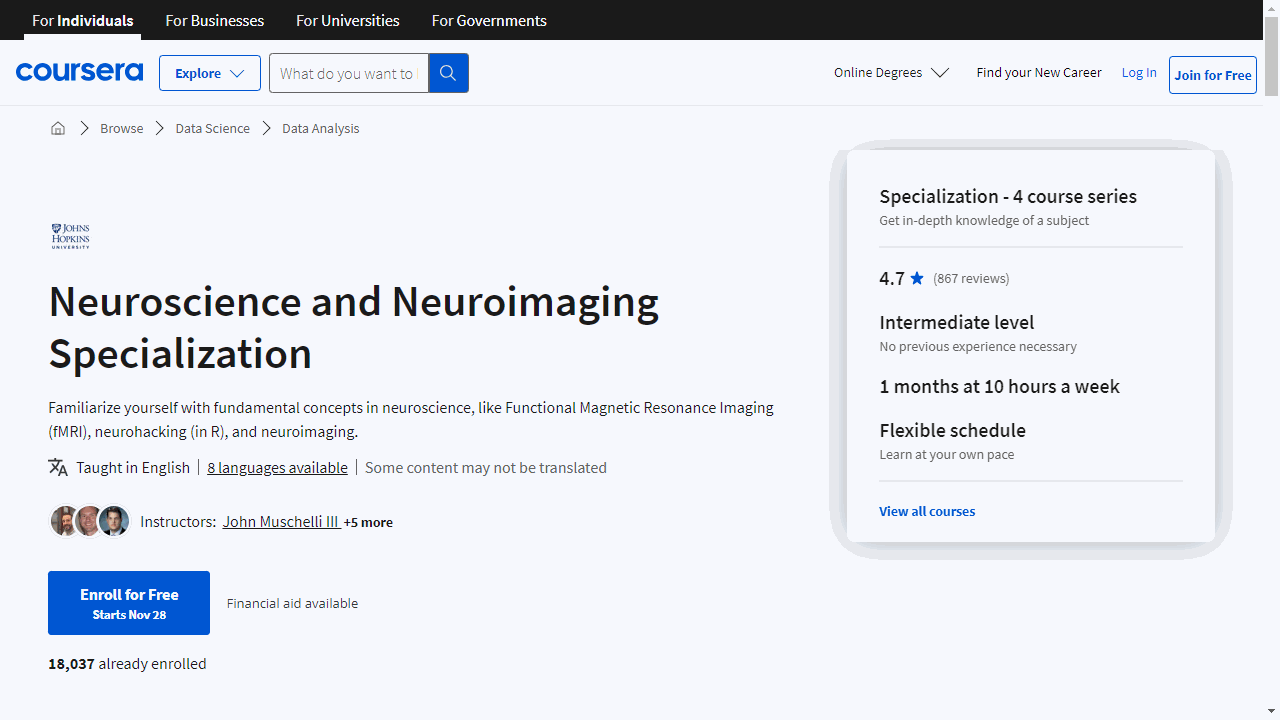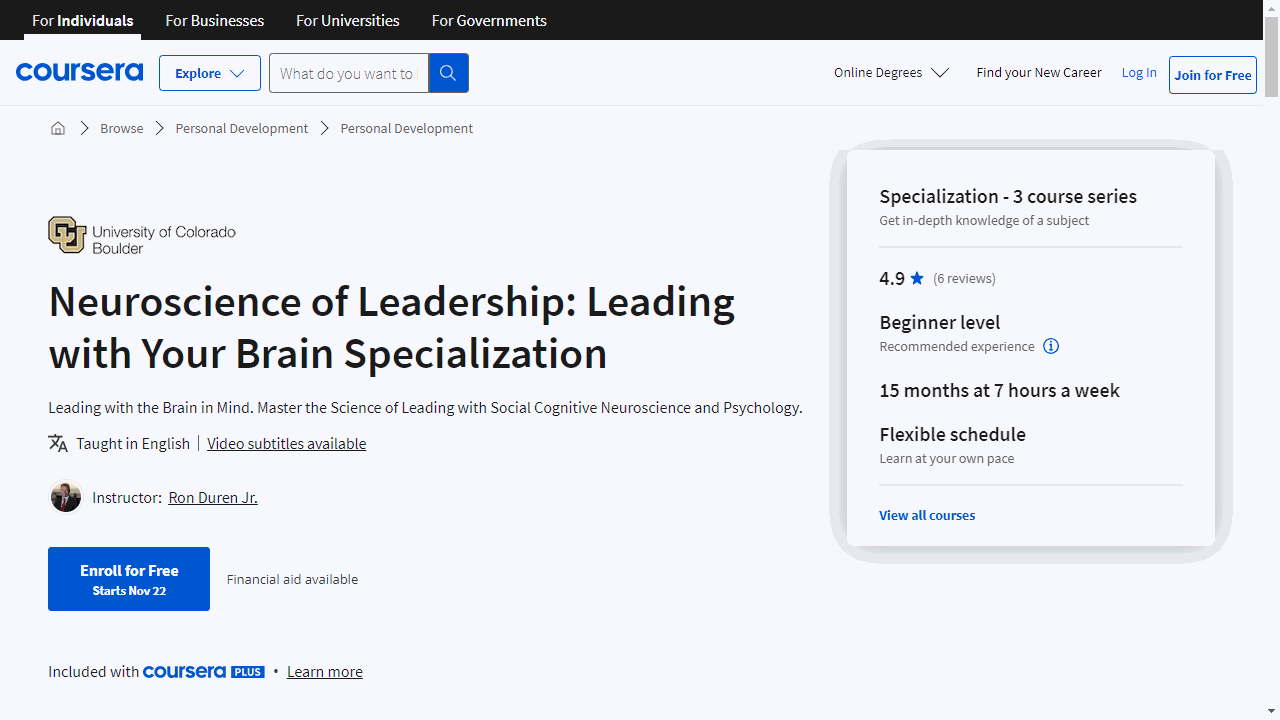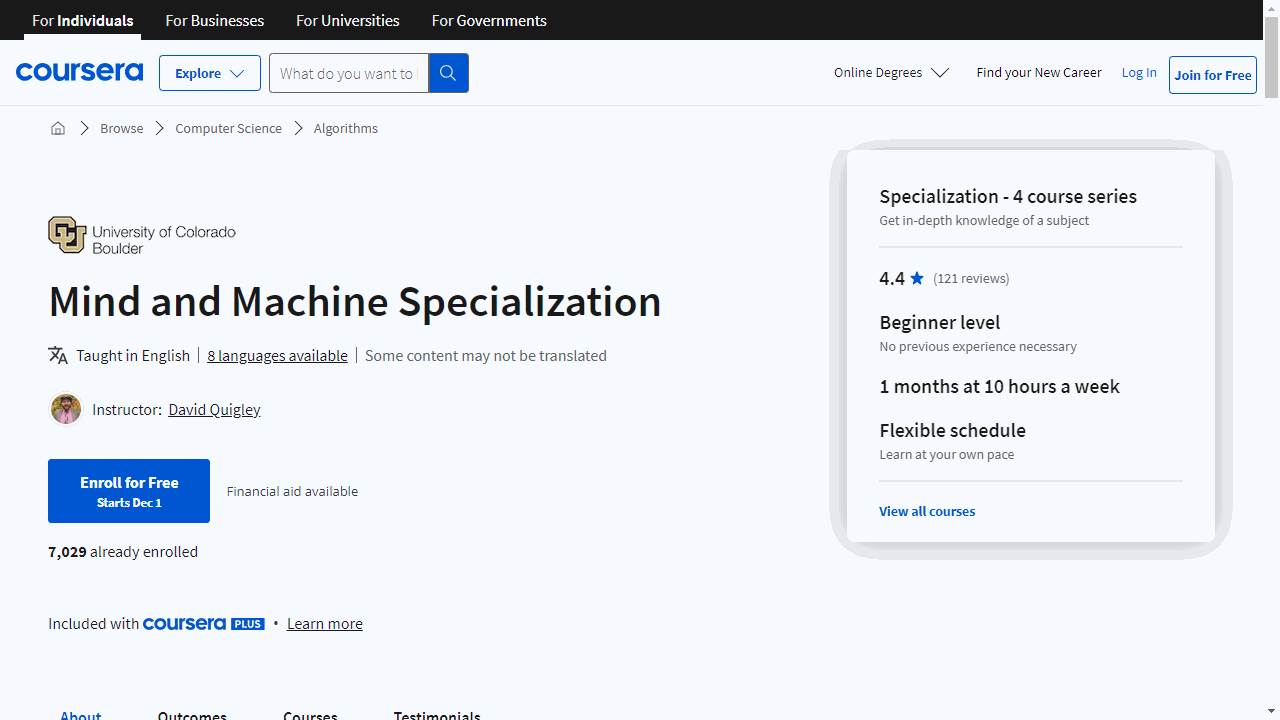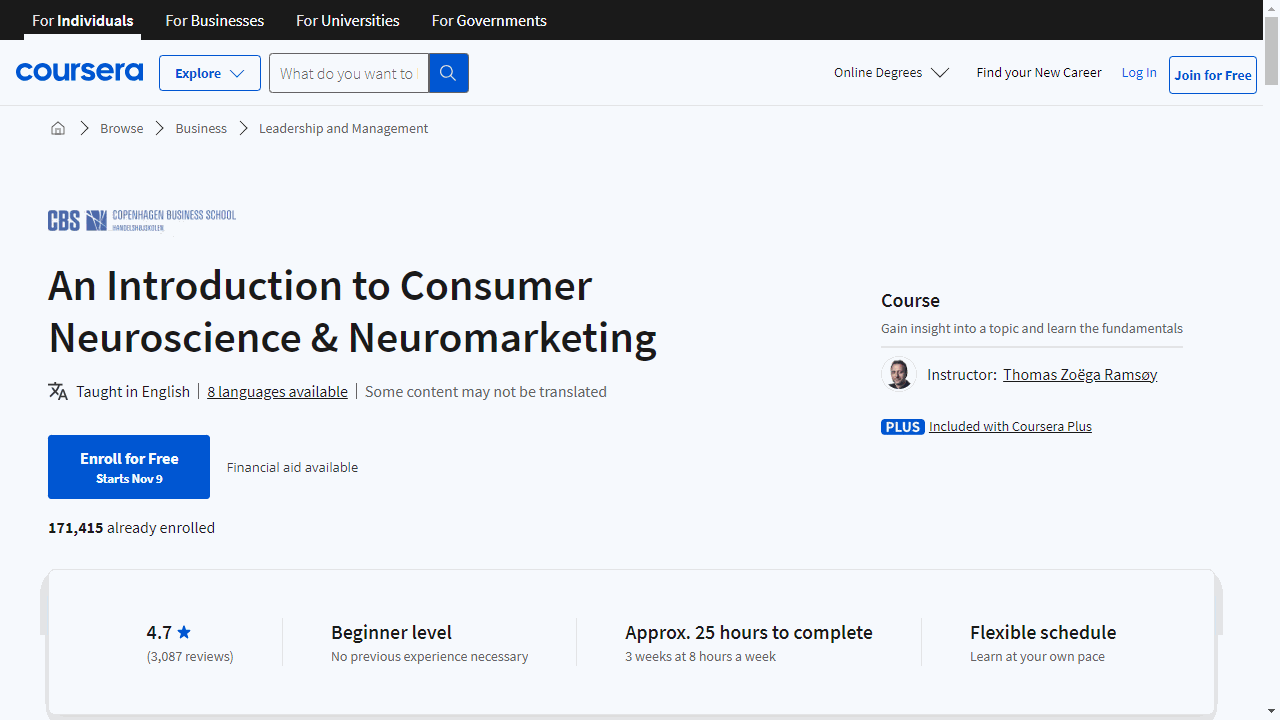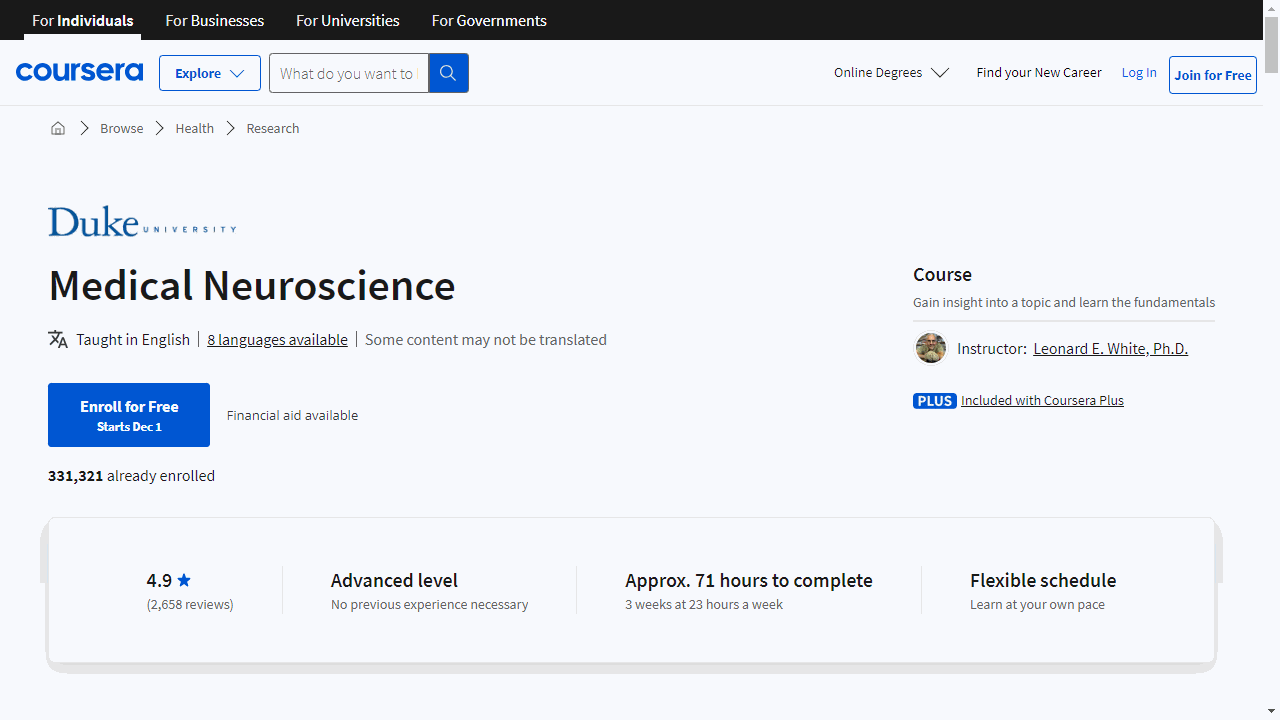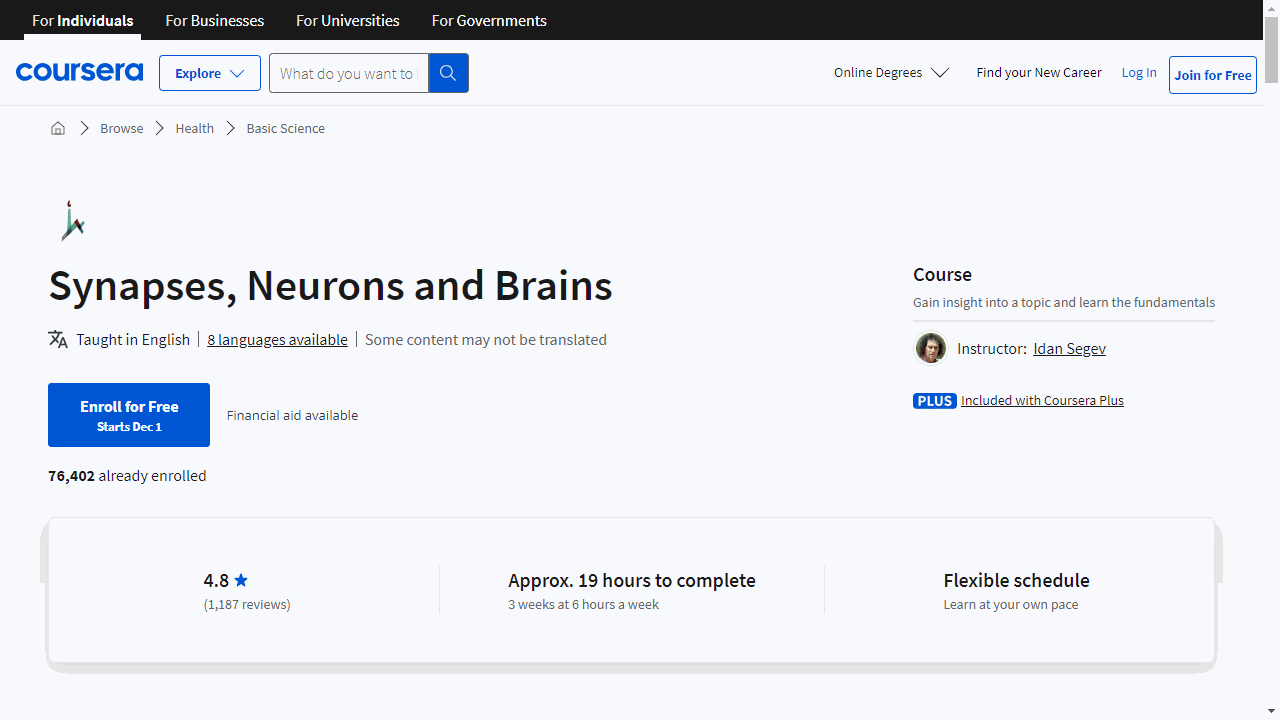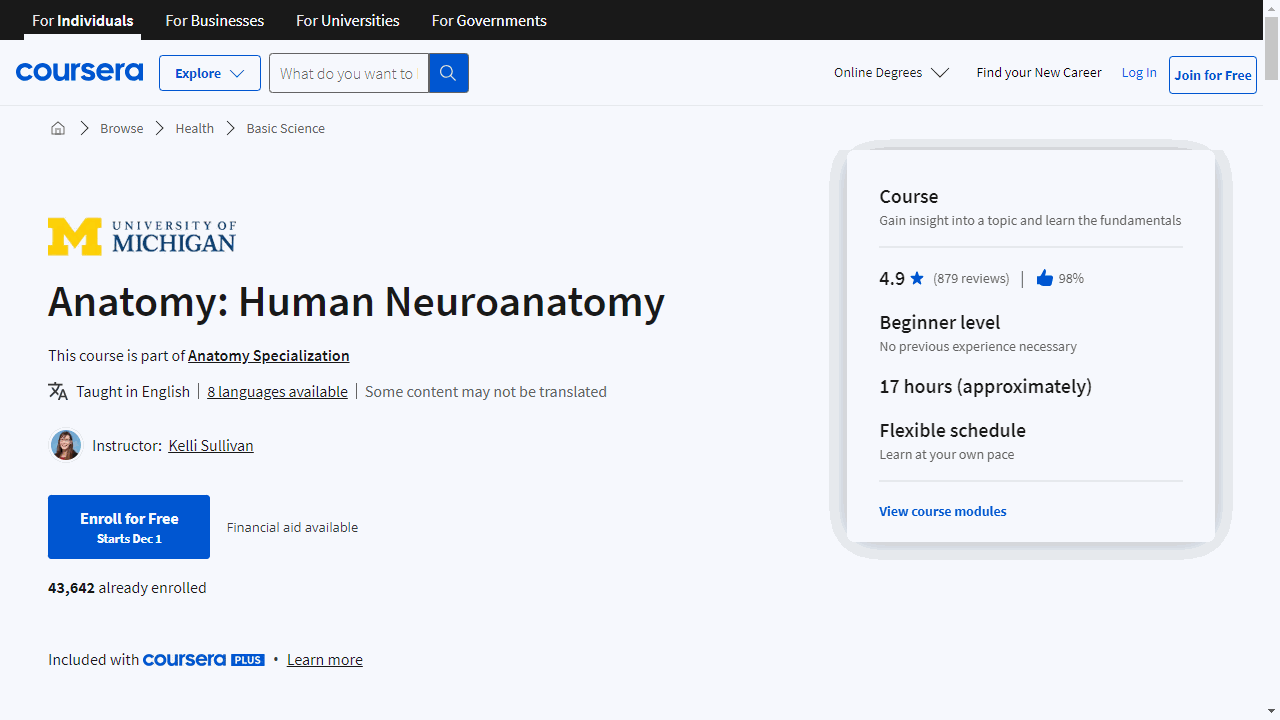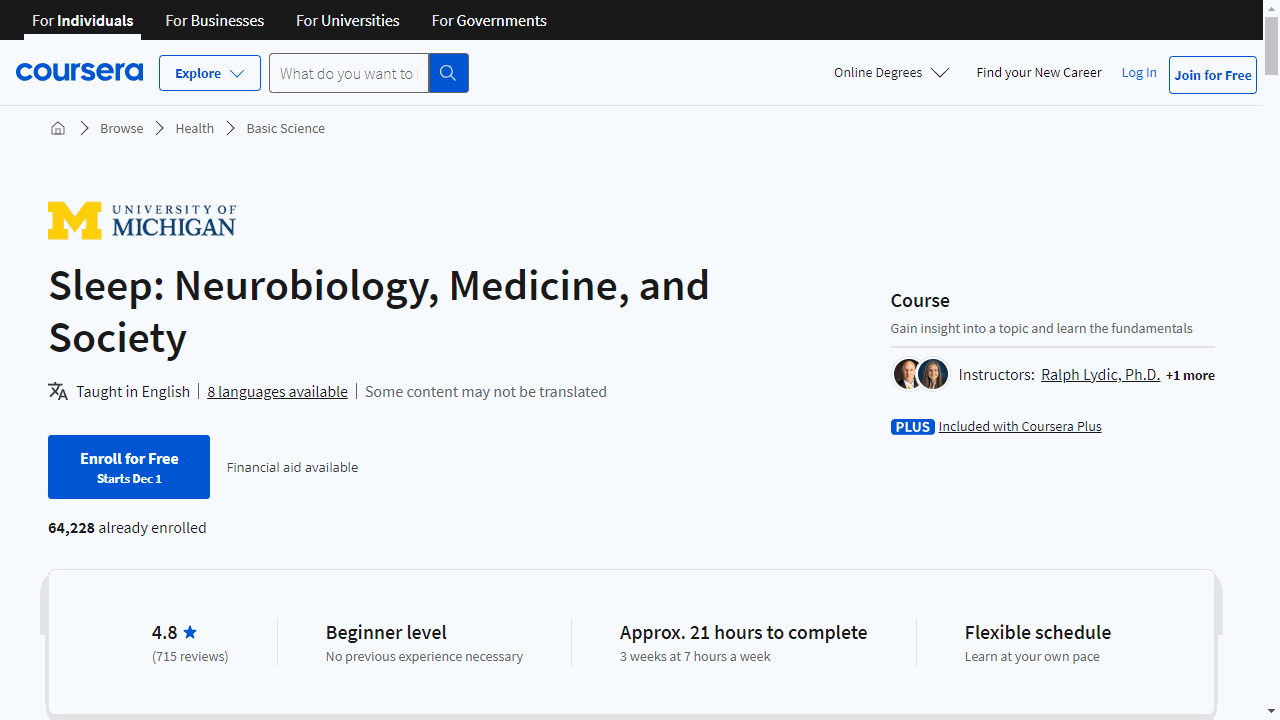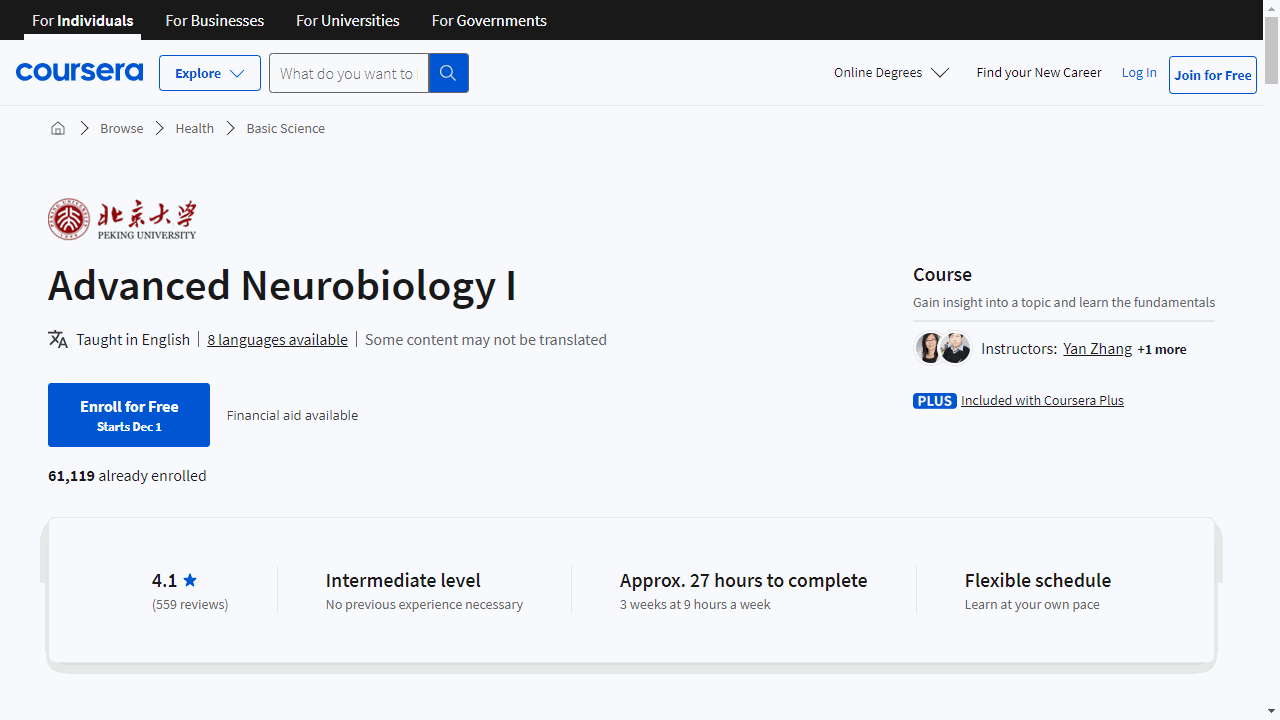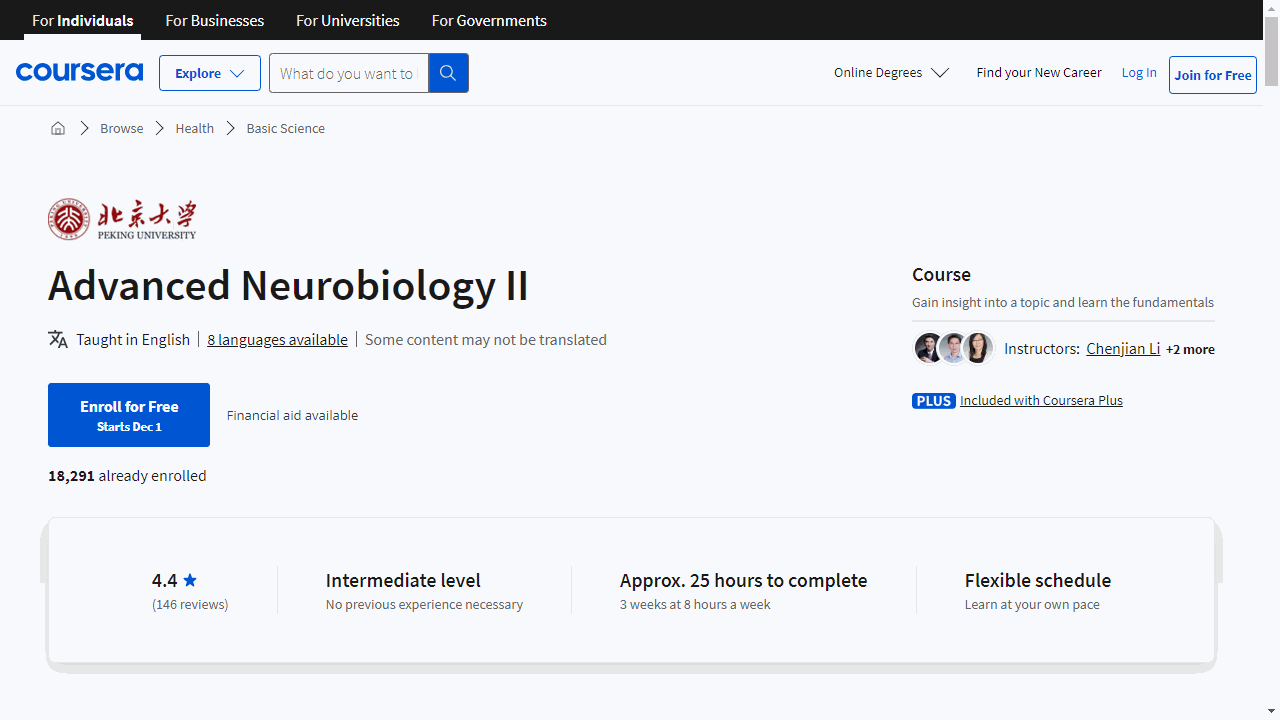Neuroscience is the study of the nervous system, which includes the brain, spinal cord, and all the nerves that connect them.
It’s a fascinating field that explores how our brains work, how we think, feel, and behave, and how our nervous system interacts with the world around us.
By learning about neuroscience, you can gain a deeper understanding of yourself, your abilities, and the human condition.
You can also learn how to apply this knowledge to improve your learning, memory, and overall well-being.
Finding a good neuroscience course can be tricky.
There are so many options out there, and it can be hard to know which one is right for you.
You want something that’s comprehensive, engaging, and taught by experts, but you also want to make sure it fits your learning style and goals.
We’ve scoured Coursera to find the best neuroscience courses and recommend Neuroscience and Neuroimaging Specialization as the best overall choice.
This program combines foundational neuroscience knowledge with cutting-edge neuroimaging techniques, providing you with a comprehensive understanding of how we study the brain.
It’s taught by leading experts in the field and includes interactive assignments and real-world case studies.
This is just the tip of the iceberg, though.
We’ve also compiled a list of the best courses for beginners, intermediate learners, and experts, as well as courses focusing on specific areas of neuroscience, such as cognitive neuroscience, neurobiology, and neuroethics.
So, keep reading to find the perfect course for your needs.
Neuroscience and Neuroimaging Specialization
This suite of courses is designed to equip you with a robust understanding of neuroimaging and its applications in neuroscience.
Starting with “Fundamental Neuroscience for Neuroimaging,” you’ll lay a solid foundation.
It’s not just about learning the techniques; you’ll delve into the history and physics behind neuroimaging, understand the brain’s structure and functions, and grasp the experimental designs used in this field.
This course is your comprehensive guide to the essentials of neuroimaging.
Then, “Principles of fMRI 1” takes you deeper, focusing on the most prevalent neuroimaging technique.
You’ll explore the intricacies of fMRI data, from acquisition to analysis.
The course demystifies complex concepts like MR Physics and Generalized Linear Models, making them accessible and applicable.
Building on that knowledge, “Principles of fMRI 2” continues your education in fMRI data analysis.
It’s a seamless transition from the first part, enhancing your ability to interpret and work with advanced neuroimaging data.
Lastly, “Introduction to Neurohacking In R” offers a practical approach to neuroimaging data analysis.
You’ll get hands-on experience with the R programming language, learning to manipulate and analyze brain images.
Skills like inhomogeneity correction and image registration are not just taught; they’re practiced, preparing you to handle real-world neuroimaging challenges.
Each course is rich with relevant content, ensuring you’re not just passively learning but actively engaging with the material.
When you finish, you’ll have a portfolio of skills highly sought after in the bioinformatics field.
Neuroscience of Leadership: Leading with Your Brain Specialization
This three-course series offers a unique approach to leadership by delving into the workings of the brain, equipping you with insights to enhance your leadership abilities.
The first course, “The Neuroscience of Personal Excellence,” offers a deep dive into the brain’s role in decision-making and behavior, especially under stress.
It’s not just about understanding your actions; it’s about mastering them.
You’ll explore how to form lasting habits, regulate emotions, and maintain mental toughness when challenges arise.
For those looking to integrate this learning into a professional setting, the option to earn academic credit through CU Boulder’s Master of Engineering in Engineering Management degree adds an extra layer of value.
Moving on to teamwork, “The Neuroscience of Leading High-Performance Teams” shifts the focus to the dynamics of group success.
This course tackles the challenge of disengagement in teams, providing strategies to foster motivation and collaboration.
You’ll learn the art of storytelling as a leadership tool and how to establish trust within your team, essential for any leader aiming to inspire and drive performance.
Lastly, “The Neuroscience of Leading Transformational Organizations” prepares you to steer organizations through the evolving landscape of human capital.
It’s about creating a culture that embraces innovation and diversity, and where employees are engaged and productive.
This course equips you with the knowledge to navigate change with confidence and understand the neuroscience behind business applications.
Each course is designed to build on your existing skills, whether in psychology, business, creativity, or innovation.
You’ll gain a comprehensive understanding of how neuroscience principles can be applied to leadership, from improving strategic reasoning to developing perseverance.
Mind and Machine Specialization
This specialization is a deep dive into the intersection of cognitive science and artificial intelligence, tailored for your curiosity.
In “What is ’the mind’ and what is artificial intelligence?” you’ll dissect the Turing test and Searle’s Chinese Room thought experiment, understanding their significance and limitations.
This course doesn’t just present concepts; it challenges you to consider the implications of AI that can mimic human thought.
“Methods for Solving Problems” equips you with strategies to dissect complex issues.
You’ll learn to identify biases in decision-making and apply heuristic and probability models to enhance your judgment.
It’s a practical guide to refining your problem-solving prowess.
“Computational Vision” offers a window into how we and machines interpret visual information.
You’ll compare human and machine vision models, including the geon model and neural network approaches, gaining insights into the challenges of teaching machines to ‘see.’
Lastly, “Interpersonal, Developmental, and Evolutionary Perspectives of the Mind” broadens your understanding of decision-making within social and evolutionary contexts.
You’ll explore game theory, including the Prisoner’s Dilemma, and delve into the design of autonomous agents, bridging the gap between natural and artificial life.
Each course is rich with content, yet presented in a way that’s accessible and engaging.
Libertarian Free Will Specialization
This series of courses merges philosophical inquiry with neuroscience, offering a comprehensive look at human autonomy.
In “The Basics of Libertarian Free Will,” you’ll dissect the philosophical arguments surrounding free will.
You’ll learn to distinguish between different types of freedom and understand how our perceptions shape our sense of reality.
The course culminates in a critical analysis of free will’s compatibility with determinism, equipping you with the tools to navigate this complex debate.
Moving on to “Free Will and Neuroscience,” this course confronts the neuroscientific challenges to free will, examining pivotal studies by Libet and Wegner.
You’ll gain insight into neuron function and communication, and how these processes relate to consciousness and voluntary action.
The course also covers the brain’s plasticity, revealing how neural circuits adapt and influence behavior.
Lastly, “Neural Basis of Imagination, Free Will, and Morality” connects the dots between neuroscience and human ethics.
You’ll explore the evolution of imagination and its impact on innovation.
The course also tackles the origins of morality and the brain’s role in ethical decision-making, providing a nuanced understanding of how we navigate moral landscapes.
By enrolling in these courses, you’ll develop critical thinking skills and a nuanced understanding of the interplay between the brain and free will.
An Introduction to Consumer Neuroscience & Neuromarketing
This course offers a unique blend of psychology and scientific marketing, providing insights into the consumer’s mind that traditional marketing courses often overlook.
The journey begins with a fundamental understanding of the brain’s structure and function.
This foundational knowledge is critical for grasping how neurological processes influence purchasing decisions.
You’ll explore this through cutting-edge fMRI case studies, which reveal the brain’s reactions to various marketing stimuli.
Next, the course delves into the realm of attention and consciousness.
You’ll learn how marketers capture and hold consumer attention in an increasingly cluttered media landscape.
Insights from industry expert Kyle Nel and the application of tools like Neurovision will give you a practical edge.
Sensory marketing is another highlight.
The course examines how sensory experiences shape consumer perceptions and behaviors, supported by expert interviews and the Sensory Load Chart.
This segment underscores the importance of engaging all senses in marketing strategies.
Emotions play a pivotal role in consumer choices, and this course addresses that head-on.
Through case studies and EEG methods, you’ll understand the emotional underpinnings of consumer behavior.
Interviews with thought leaders like Steve Genco enrich this section with real-world applications.
The course also covers the impact of learning and memory on marketing, using eye-tracking and memory tests to illustrate how brands can create lasting impressions.
Finally, the course tackles the ethical considerations of neuromarketing.
Through candid discussions with professionals like Jan Trzaskowksi and Carl Marci, you’ll be encouraged to consider the moral implications of using neuroscience in marketing.
By understanding the science behind consumer behavior, you’ll be positioned to create more effective and ethical marketing campaigns.
In essence, “An Introduction to Consumer Neuroscience & Neuromarketing” is a comprehensive course that bridges the gap between marketing and brain science.
It’s an investment in a skill set that will significantly enhance your approach to marketing, making your strategies more empathetic and scientifically informed.
Understanding the Brain: The Neurobiology of Everyday Life
This course kicks off with a compelling narrative, the Bauby Story, setting the stage for a deep dive into the ethics and personal impact of brain science.
You’ll get an intimate look at the brain’s core functions and central anatomy, starting with neurons—the brain’s building blocks.
The course simplifies complex concepts like neuronal function, demyelinating diseases, and the role of glial cells, ensuring you grasp the fundamentals without getting lost in jargon.
Electrical signaling is at the heart of neurobiology, and you’ll explore this in detail, from action potentials to neurotransmitter mechanics.
The course even demystifies how treatments like Botox work at a cellular level.
Beyond the biology, you’ll learn about the brain’s role in emotion, discovering the delicate interplay between the nervous system’s different parts.
The course also offers practical insights into how injuries, like spinal cord damage, disrupt this balance.
Hands-on activities, such as creating a brain schematic, make neuroanatomy engaging.
You’ll understand cerebral blood flow, the impact of strokes, and the intricacies of the visual and auditory systems.
The course doesn’t just tell you how things work; it shows you, with interactive quizzes and additional resources to support your learning journey.
Movement and balance are covered through an examination of the motor hierarchy and the vestibular system.
You’ll see how the cerebellum and basal ganglia contribute to coordination and learning, and how these processes can be disrupted by disorders.
The course also tackles the regulation of body functions, from temperature control to sleep, giving you a comprehensive view of homeostasis.
You’ll delve into the hypothalamus and pituitary gland’s roles, gaining insights into conditions like gigantism and post-partum mood disorders.
Finally, you’ll explore the brain’s abstract functions, including memory and language.
Real-life cases provide context for these complex topics, making them relatable and understandable.
Medical Neuroscience
Led by Professor Leonard White (Duke University), this course is a comprehensive journey through the brain’s intricate landscape.
Starting with an overview of medical neuroscience, you’ll quickly move from observer to active participant.
The course is structured to make complex concepts accessible, with a wealth of resources to guide you.
You’ll join Professor White on a “Neur-run,” a unique approach to exploring brain anatomy, supported by a dedicated mentor team.
The syllabus takes you through the brain’s surface anatomy, delving into the lateral, medial, and ventral aspects.
It’s like constructing a 3D model of the brain, piece by piece.
You’ll gain a clear understanding of the brain’s blood supply and cranial nerves, learning to locate and describe their functions with ease.
Electrical signaling, including action potentials and synaptic transmission, is demystified, revealing the brain’s communication network.
This foundational knowledge is crucial for grasping how we process information and respond to the environment.
Sensory and motor systems are covered in depth, offering insights into how we interact with the world and control our movements.
The course breaks down complex topics like sensory pathways and motor control into digestible segments, ensuring you grasp each concept before moving on.
Beyond the basics, the syllabus includes developmental neuroscience, cognition, sleep, emotions, and the mechanisms of addiction.
Each section is designed to build on the previous, creating a layered understanding of the brain’s functions and behaviors.
As you approach the comprehensive final exam, you’ll feel equipped with a robust understanding of neuroscience.
Professor White’s closing remarks will underscore the transformative nature of the course, leaving you with a profound appreciation for the brain’s capabilities.
Synapses, Neurons and Brains
This course takes you on an insightful journey into the brain’s intricate workings, starting with an introduction to the brain’s evolution and the groundbreaking concept of the connectome.
You’ll dive into the neuron’s role as the brain’s fundamental unit, learning how these cells communicate and function as input/output devices.
The course breaks down complex ideas like synaptic potentials and the neuron’s circuit-like behavior, ensuring you grasp the underlying principles of neuronal communication.
As you progress, you’ll uncover the secrets of learning and memory, exploring the brain’s remarkable ability to adapt and grow through neurogenesis.
The course also tackles the brain’s computational abilities, introducing you to theories like the Rall Cable Theory, which explains how dendrites contribute to processing information.
You’ll get a behind-the-scenes look at ambitious projects like the Blue Brain Project, which simulates brain activity, offering insights into everything from a single cortical column to the human brain as a whole.
The course also covers sensory information processing, guiding you through the journey from basic perception to complex emotional responses.
Plus, it addresses thought-provoking topics like free will and thought reading, encouraging you to engage with some of neuroscience’s most challenging questions.
Computational Neuroscience
It starts with an introduction to computational models, giving you a solid foundation in how these models help us understand brain function.
You’ll delve into the electrical properties of neurons and synapses, uncovering the basics of brain communication.
This sets the stage for exploring brain networks and their roles, providing a clear picture of how different brain areas interact.
The course then guides you through the neural code, teaching you to interpret brain signals through models and feature selection.
You’ll tackle neural variability, gaining insight into why neurons sometimes signal unexpectedly.
Neural decoding is up next, where you’ll apply signal detection theory and Bayesian estimation to infer brain activity.
This section is like learning a new language, allowing you to translate neural data into meaningful insights.
In week 4, you’ll explore information theory, focusing on entropy and how to quantify information in neural signals.
This knowledge is crucial for understanding the brain’s communication strategies.
Modeling neurons is a core part of the course, where you’ll examine spikes, simplified models, and dendritic structures.
You’ll appreciate how neurons and their connections form the basis of brain function.
The course also covers synaptic plasticity and learning principles, revealing how the brain adapts and forms new connections.
You’ll explore unsupervised learning, seeing how the brain organizes information without explicit guidance.
Lastly, you’ll discover how neurons can act as classifiers through supervised learning and how reinforcement learning influences behavior.
The course even touches on brain-computer interfaces, showcasing the cutting-edge of neuroscience research.
Throughout the course, practical tutorials in Matlab, Octave, and Python ensure you can apply what you learn.
With comprehensive lecture notes and quizzes, you’ll have all the resources you need to master the material.
Anatomy: Human Neuroanatomy
It kicks off with a clear introduction to neuroanatomy, guiding you through the central nervous system and the brain’s structure, including the protective meninges.
You’ll gain a thorough understanding of the neurovasculature, the brain’s blood vessel network, and the ventricular system, complete with a hands-on demonstration that brings these concepts to life.
As you explore the spinal cord, you’ll grasp the essentials of gray and white matter and the significance of spinal nerves and plexuses.
The course also demystifies reflexes, those instant reactions that safeguard us.
Dive into the autonomic nervous system, where you’ll differentiate between the parasympathetic system, which calms us, and the sympathetic system, which primes us for action.
The motor system modules will reveal how our brains initiate and regulate movement, with a focus on the basal nuclei and the cerebellum’s role in movement coordination.
Sensory systems are thoroughly covered, from the basics of touch, pain, and temperature to the precision of fine touch.
You’ll even get a glimpse into how these senses are clinically examined.
The brain stem might be small, but its impact is huge.
You’ll study its components, including the medulla oblongata and midbrain, and delve into the diverse functions of the 12 cranial nerves that influence our senses and movements.
The cerebral cortex, subcortical white matter, diencephalon, hippocampus, and amygdala are all unpacked, offering insights into memory, emotions, and cognitive processing.
Throughout the course, interactive discussions and feedback sessions enrich the learning experience, and you’re encouraged to continue your journey with Michigan Online.
Sleep: Neurobiology, Medicine, and Society
Led by Dr. Ralph Lydic and other experts, this course offers a comprehensive look at sleep’s role in our lives.
You’ll start with the basics, learning about the brain chemicals that control sleep and wakefulness.
The course breaks down complex concepts like monoamines, acetylcholine, GABA, and orexin into understandable parts, showing you how they influence your sleep.
Then, you’ll dive into the science behind sleep with mathematical models like the Two Process and Flip-Flop models.
These aren’t just theoretical; they’re tools that scientists use to predict sleep patterns and understand sleep regulation.
The practical side of sleep is also covered extensively.
You’ll explore sleep medicine, including how to diagnose and treat disorders like sleep apnea.
The course doesn’t shy away from the tough stuff, discussing the impact of sleep on cardiovascular health and its interplay with psychiatric conditions.
Insomnia gets a close look, too.
You’ll learn about its causes, consequences, and treatments, both medicinal and behavioral.
The course even walks you through cognitive behavioral therapy for insomnia (CBT-I), a leading treatment method.
Curious about the link between sleep and anesthesia?
This course has answers, examining their shared mechanisms and functions.
Beyond the science, you’ll understand why sleep matters for your health, how it changes with age, and tips for maintaining a healthy sleep cycle.
Lastly, the course tackles daytime sleepiness, its societal impact, and how it’s measured and managed.
Advanced Neurobiology I
This course is designed to deepen your understanding of the nervous system in a comprehensive yet digestible format.
Starting with the essentials, you’ll master neurobiology terminology, setting a solid foundation for the intricate topics ahead.
You’ll explore the central nervous system, uncovering the complexities of the blood-brain barrier and the protective meninges.
The course also demystifies brain structures like the telencephalon and the hippocampus, crucial for cognitive functions such as memory.
You’ll delve into the brain’s communication pathways, examining the brain stem, cranial nerves, and the spinal cord.
This knowledge is vital for grasping how the brain interacts with the rest of the body.
The course doesn’t shy away from the technical side, either.
You’ll get an up-close look at neurons through advanced microscopy techniques and learn about groundbreaking methods like the “brainbow” technique, which vividly illustrates neural connections.
Understanding neurological diseases is another key component.
You’ll gain insights into the pathology and treatment of Alzheimer’s and Parkinson’s diseases, equipping you with knowledge that’s both academically and personally valuable.
Electrophysiology is also a major focus.
The course breaks down complex concepts like ion channels and membrane potentials into understandable segments, revealing the electrical essence of neuronal function.
Moreover, the course features contributions from renowned neuroscientists Dr. Kang Shen and Dr. Liqun Luo, providing you with a window into cutting-edge research and real-world applications.
Finally, if you’re intrigued by how the brain adapts and learns, the sections on synaptic transmission and plasticity will captivate you.
These lessons are central to understanding the mechanisms behind learning and memory.
Advanced Neurobiology II
This is the second part of the journey started by the course above.
Dive into the mechanics of sensation, starting with the various ways we sense our environment.
You’ll unravel the process of sensory transduction, discovering how stimuli like light and sound are converted into neural signals.
This isn’t just textbook theory; it’s the science behind everyday experiences, like recognizing colors and discerning temperatures.
The course goes beyond the basics, delving into the complexities of sensory processing.
You’ll gain insights into vision, exploring the intricacies of phototransduction and the nuances of color perception.
The curriculum also tackles auditory processing, offering a clear understanding of how we hear and locate sounds.
Your exploration continues with chemoreception, where you’ll learn about the olfactory system and taste receptors.
This section is a deep dive into how we smell and taste, revealing the genetic and molecular underpinnings of these senses.
Touch is another focus, with detailed discussions on the somatosensory system.
You’ll explore how our bodies detect and interpret touch, pressure, and pain, gaining knowledge about mechanosensory neurons and mechanotransduction channels.
Sleep and circadian rhythms are also covered, shedding light on the biological clocks that regulate our sleep-wake cycles.
This segment is crucial for understanding how rest impacts brain function.
The course then transitions to movement and control, examining the central nervous system and the interplay between the brain and spinal cord.
You’ll also confront the realities of neurological diseases, learning about the genetic factors involved and their implications for treatment and research.
For those intrigued by the psychological aspects of neurobiology, the course offers a rich exploration of mood disorders, addiction, and other mental health topics.
You’ll delve into the dopamine system, mood regulation, and the genetic and environmental factors that influence mental health.
Finally, the course culminates with a study of behavior, from the genetic basis of sex differences to the hormonal influences on behavior.
You’ll leave with a holistic understanding of how the brain governs actions and responses.
